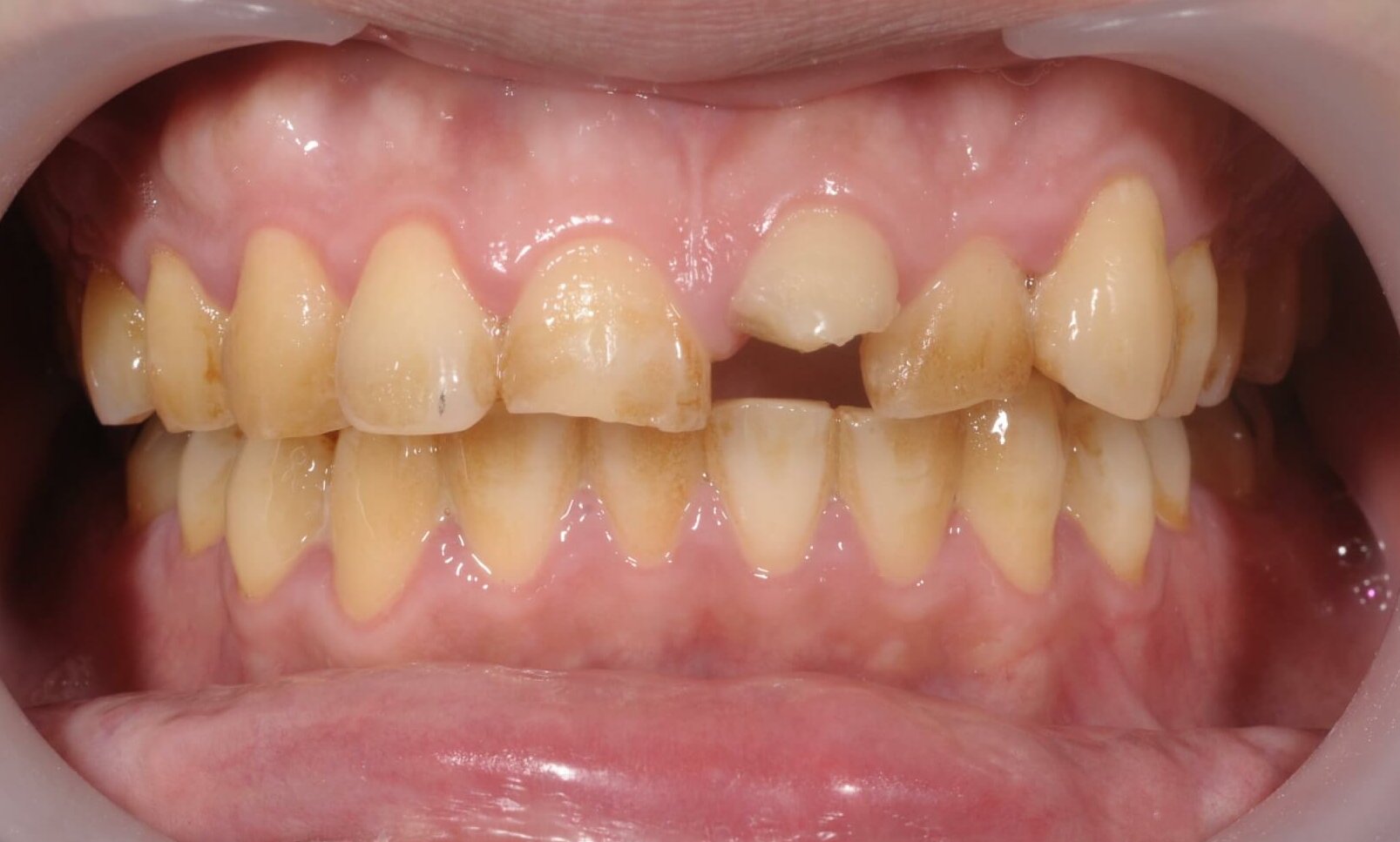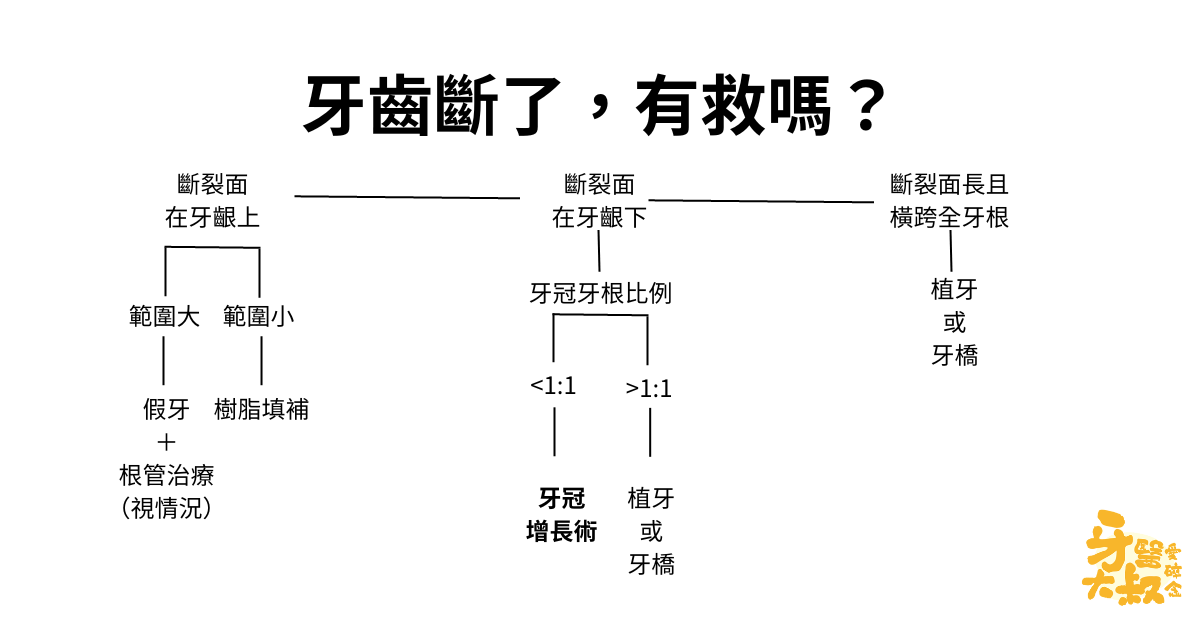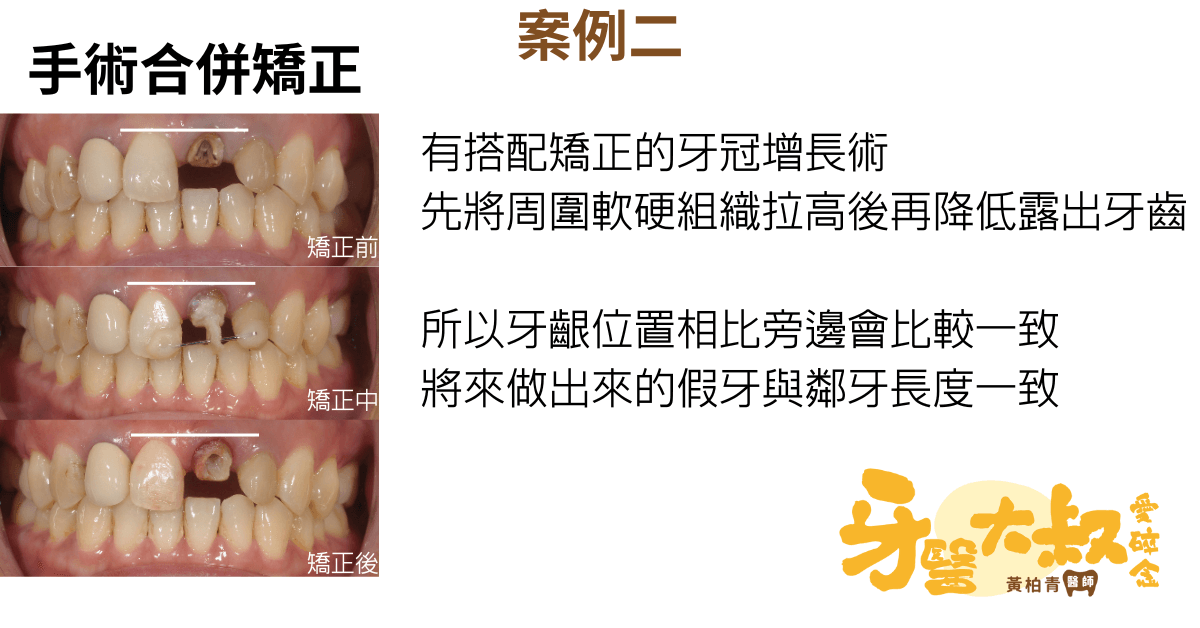
那一天,看診的時候,大叔突然接到一個緊急任務。老患者王先生車禍撞到門牙,跑來大叔的門診,很緊張地詢問怎麼辦?是不是牙齒撞斷了就要拔掉植牙?
On that day, during a professional consultation, I suddenly received an urgent mission. An elderly patient named Mr. Wang had a car accident and knocked his front tooth. He came to my clinic anxiously and asked me what to do. He was worried whether the tooth needed to be extracted and replaced with a dental implant.

什麼狀況容易牙齒斷裂?There are several factors that can cause teeth to fracture
我們可以分為三方面來討論 some of the common reasons include:
外力External forces
車禍、外力撞擊、咬到硬物、或是平常喜歡咬硬物或是嚼食檳榔是常見的牙齒斷裂原因。
Car accidents, impact from external forces, biting hard objects, or habitual chewing of betel nut are common causes of tooth fractures.
病理性因素Pathological factors
太深的蛀牙或牙齒磨耗會造成牙齒齒質的受損、咬肌發達咬力過重容易超過牙齒能承受的力量,這兩項也可能造成牙齒斷裂。
Deep cavities or teeth wear can cause damage to the tooth structure, and overdeveloped biting muscles and excessive biting force can exceed the strength that teeth can bear, both of which can lead to tooth fractures.
咬合因素Malocclusion factors
不正常的咬合關係,例如深咬或錯咬,常會有額外的力量施加在某部分的牙齒上造成這些牙齒有比一般高的斷裂風險。
Abnormal Malocclusion relationships, such as deep bites or crossbites, often exert additional force on certain teeth, resulting in a higher risk of fracture than normal teeth.

牙齒斷了還有救嗎?Is there still a way to save a broken tooth?
我們可以把牙齒斷裂分為幾種情況We can categorize tooth fractures into several types
1.斷裂面在牙齦上方Fracture above the gumline::
如果斷裂面全都在牙齦上方,那這顆牙齒有蠻大的機會留下來。斷裂面積小的可以使用樹脂填補。斷裂面積大的則會建議以假牙來做修復,如斷裂部位有傷害到神經,則需要合併根管治療。
If the fracture is above the gumline, there is a good chance that the tooth can be saved. For small fractures, resin filling can be used for repair. For larger fractures, a dental prosthesis may be recommended for repair. If the fracture has damaged the pulp, root canal therapy may be required in conjunction with the repair.
2.斷裂面在牙齦下
如果牙齒斷裂面有一部分在牙齦下,要判斷牙齒留不留得住第一步通常是以牙冠牙根比來做考量。從斷裂面下2mm到牙齒頂端為牙冠長度,到根尖為牙根長度,牙冠牙根長度比決定牙齒的去留。
如果牙冠牙根比<1:1,代表你的牙根比牙冠長,這樣牙齒才會穩固。如果牙冠牙根比>1:1,代表你的牙冠比牙根長,可能會出現頭重腳輕的狀況,這時候就建議拔除,考慮牙橋或是植牙的治療方式。從X光上就可以大致判斷牙冠牙根的比例來決定這顆牙齒的去留。
If part of the tooth fracture is below the gingival, the first step in determining whether the tooth can be saved is usually to evaluate the ratio of the tooth crown to root (Crown/root ration).From the fracture surface 2mm below the tooth crown to the top of the tooth is the tooth crown length, and from the root tip is the tooth root length. The ratio of tooth crown length to tooth root length determines the retention or loss of the tooth.The proportion of the crown and root can be roughly determined from an X-ray to decide whether to keep or remove the tooth.
If the tooth crown/root ratio is <1:1, it means that your tooth root is longer than the tooth crown, which makes the tooth more stable. If the tooth crown to root ratio is >1:1, it means that your tooth crown is longer than the tooth root, and there may be a risk of instability. In this case, it is recommended to extract the tooth and consider treatment options such as a dental bridge or dental implant.
3.斷裂面長且橫跨牙根Fracture line is long and transverse across the root of the tooth
當發生這個狀況時,通常牙齒就得拔掉了。這時候可以考慮以植牙或是牙橋來回復功能及美觀。
When this situation occurs, the tooth usually needs to be extracted. At this point, dental implants or bridges can be considered to restore function and aesthetics.”

牙冠牙根比例對於預後的影響Impact of Crown-to-Root Ratio on Prognosis
正常前況下,牙冠(就是露出在牙齦外的部分)一定是比牙根(牙齦裡的部分)短的,這樣才不會頭重腳輕。當我們牙齒斷裂,為了假牙的包覆性,會把假牙邊緣往牙根方向延伸,造成牙冠變長,牙根變短而改變牙冠牙根比,目前來說極限的比例就是1:1,大於這個比例就表示牙冠比牙根長,容易造成根基不穩,牙齒晃動,
所以斷掉的牙齒能不能留,牙冠牙根的比例是重點考量之一,如果你的牙根天生比別人長,那就有更多機會保留這顆牙齒。
Under normal circumstances, the crown of a tooth (the part that is visible above the gumline) is always shorter than the root (the part within the gum). This ensures a balanced structure. When a tooth fractures, in order to provide adequate coverage for a dental prosthesis, the margin of the prosthesis is extended towards the root, resulting in a longer crown and a shorter root, thereby altering the crown-to-root ratio. Currently, the maximum acceptable ratio is considered to be 1:1. Ratios greater than this indicate that the crown is longer than the root, which can lead to instability and tooth mobility.
Therefore, when considering whether a broken tooth can be saved, the crown-to-root ratio is one of the key factors to consider. If your roots are naturally longer than those of others, you have a greater chance of preserving the tooth.
什麼是牙冠增長術,斷牙的救星?What is Crown Lengthening, the Savior for Broken Teeth?
如果牙冠牙根比沒有太糟的斷牙,通常可以搭配牙冠增長手術,來讓斷裂的齒質露出牙齦,在做假牙保護起來達到斷牙復形的目的。
牙冠增長術通常分為兩種:1. 單純手術,沒有搭配矯正。 2. 搭配矯正,先矯正後再手術。
Crown lengthening surgery is typically classified into two types: 1. Purely surgical approach without orthodontic treatment. 2. Combination with orthodontic treatment, where orthodontic alignment is performed prior to the surgical procedure.

牙冠增長術,沒有加上矯正 Crown Lengthening Procedure, Without Orthodontic Treatment
單純手術,將牙齒周圍的軟硬組織往牙根方向降低,露出足夠的齒質來做牙齒。牙冠變長,牙根變短,該顆牙齒的牙齦線比左右兩顆牙齒低,較適合用在非美觀的區域。
Purely surgical, the procedure involves lowering the surrounding soft and hard tissues around the tooth towards the root, exposing sufficient tooth structure for restoration. The crown of the tooth becomes longer while the root becomes shorter, resulting in a lower gum line compared to the adjacent teeth. This technique is more suitable for non-aesthetic areas where the appearance of the gum line is less critical.


牙冠增長術,加上矯正 Crown Lengthening Procedure, With Orthodontic Treatment
在手術前搭配矯正做治療,目的是先將牙齒拉高,再將周圍軟硬組織降低,來達到與周圍牙齒牙齦線一樣高度的目的。會建議使用在美觀區,除了較美觀外,牙冠牙根比例也會比單純手術的比例好,缺點是時間較長,與需要額外的矯正費用。
In conjunction with orthodontic treatment, the purpose of combining it with surgery is to first elevate the teeth and then lower the surrounding soft and hard tissues to achieve a gum line that matches the height of the surrounding teeth. This approach is recommended for aesthetic areas where achieving a harmonious gum line is important. In addition to improving aesthetics, the crown-to-root ratio is also likely to be more favorable compared to a purely surgical approach. However, it is important to note that this treatment option requires a longer duration and additional orthodontic costs.



兩種牙冠增長術的比較Comparison of Two Types of Crown Lengthening Procedures
- Purely Surgical Approach without Orthodontic Treatment:
- Purpose: The primary goal is to lower the surrounding soft and hard tissues to expose more tooth structure for restoration.
- Suitable Areas: This approach is typically recommended for non-aesthetic areas where the appearance of the gumline is less crucial.
- Crown-to-Root Ratio: The crown-to-root ratio may not be significantly improved compared to the initial state of the broken tooth.
- Procedure: The surgery involves removing excess gum tissue and, if necessary, reshaping the underlying bone to achieve the desired gumline height.
- Advantages: The procedure is relatively straightforward, and the treatment duration is usually shorter compared to the combined approach.
- Disadvantages: The aesthetic outcome may be less optimal, and the crown-to-root ratio may not be significantly improved.
- Combination with Orthodontic Treatment:
- Purpose: The objective is to first reposition the teeth orthodontically to achieve proper alignment and then perform the surgical procedure to create an aesthetically pleasing gumline.
- Suitable Areas: This approach is recommended for aesthetic areas where achieving an ideal gumline height is crucial.
- Crown-to-Root Ratio: The crown-to-root ratio is typically improved compared to the initial state of the broken tooth, resulting in a more favorable outcome.
- Procedure: The treatment involves orthodontic treatment to align the teeth properly, followed by surgical crown lengthening to adjust the gumline.
- Advantages: The aesthetic result is generally superior, and the crown-to-root ratio is often improved.
- Disadvantages: The treatment duration is longer due to the sequential nature of orthodontic and surgical procedures, and there may be additional costs associated with orthodontic treatment.
Ultimately, the choice between the two approaches depends on the specific case, the aesthetic considerations, and the desired outcome. Consulting with a dental professional can help determine the most appropriate approach for crown lengthening based on individual circumstances.

牙齒斷了,有救嗎?Can a Broken Tooth Be Saved?
When a tooth is broken, several factors need to be considered to determine if it can be saved:
- Condition of the Broken Tooth: The extent of the tooth fracture and the presence of any underlying decay or infection will be assessed. If the damage is minimal and the tooth’s structure can be restored, there is a higher chance of saving the tooth.
- Cause of the Tooth Fracture: Understanding why the tooth broke is crucial in preventing future fractures. Common causes include trauma from accidents, biting into hard objects, or weakened tooth structure due to decay or previous dental treatments.
- Evaluation of the Overall Bite: The alignment and occlusion (bite) of the teeth play a role in determining the prognosis of a broken tooth. If the bite is misaligned or there is excessive force on the affected tooth, it may be more prone to further damage.
By considering these factors, a dentist can determine the appropriate treatment plan to save the broken tooth. This may involve procedures such as dental bonding, dental crowns, root canal treatment, or in severe cases, extraction followed by a prosthetic replacement. Regular dental check-ups and maintaining good oral hygiene are essential in preventing future tooth fractures and preserving oral health.
- 你可能想了解: 隱適美是什麼?隱適美矯正常見的Q&A
- 你可能想了解:我適合隱適美嗎?與傳統矯正的差別?4類人適合隱適美
- 你可能想了解:隱適美矯正前的評估有哪些?矯正評估費用?了解矯正前評估流程。
